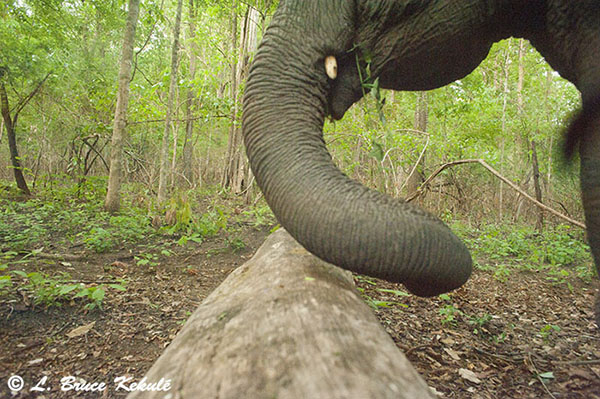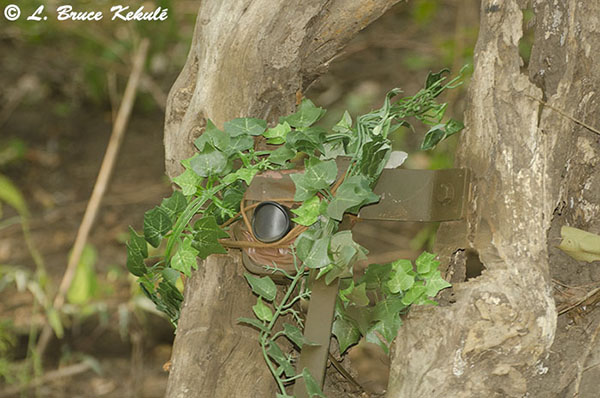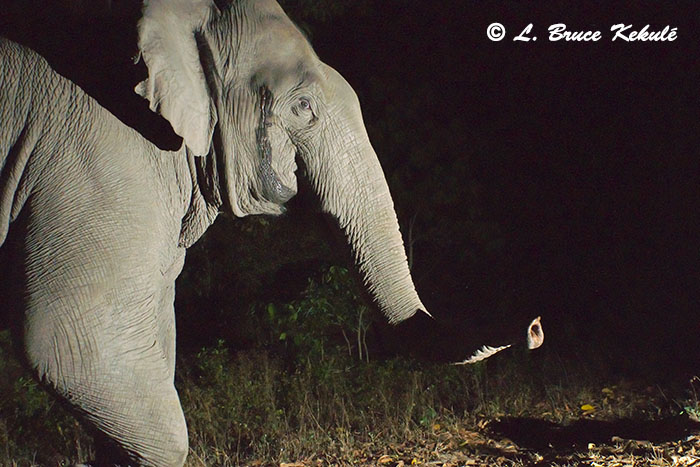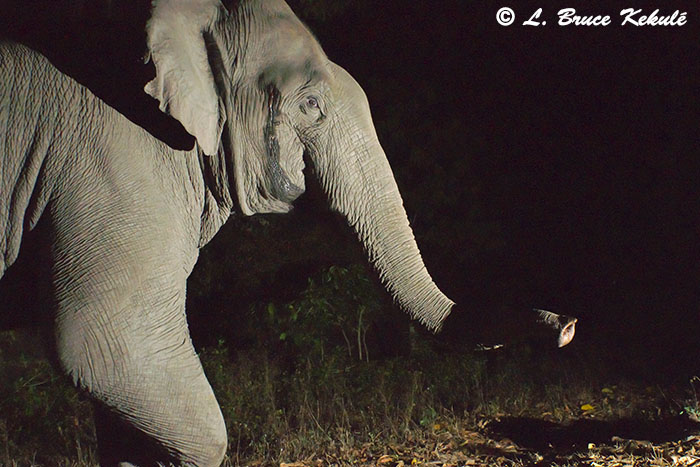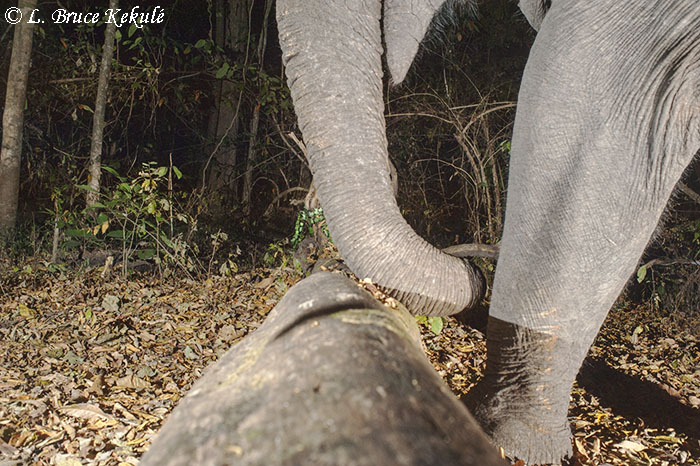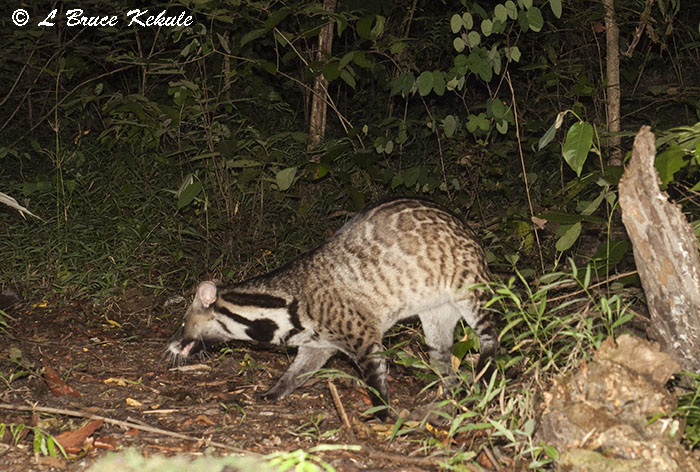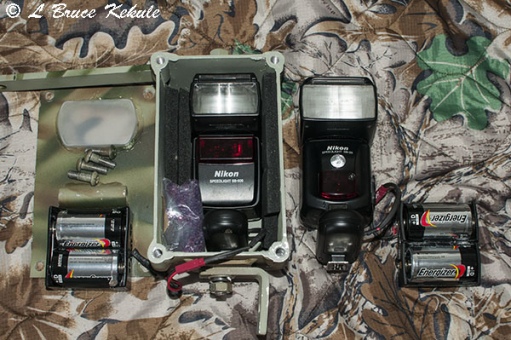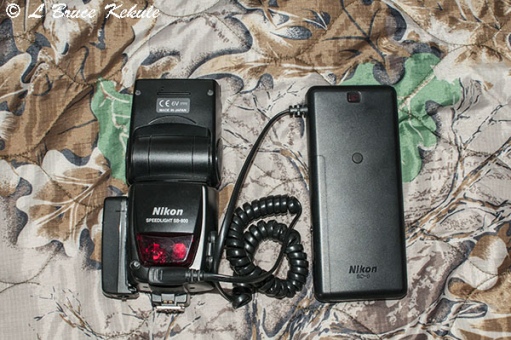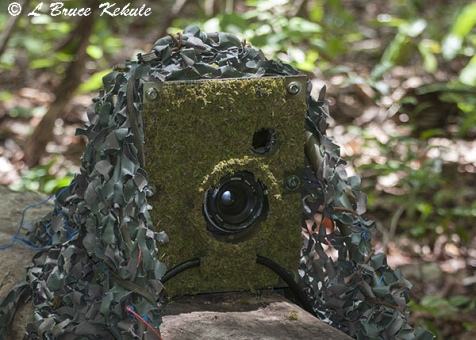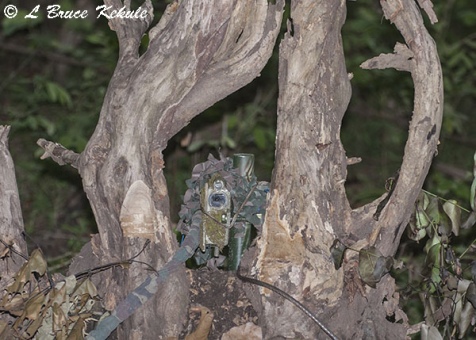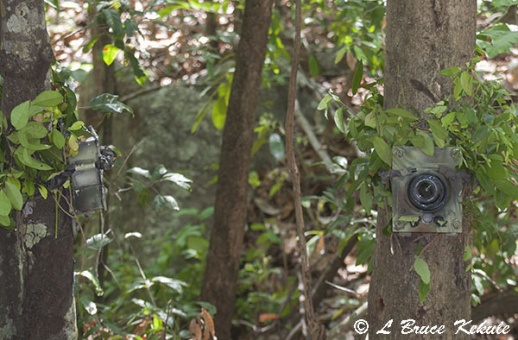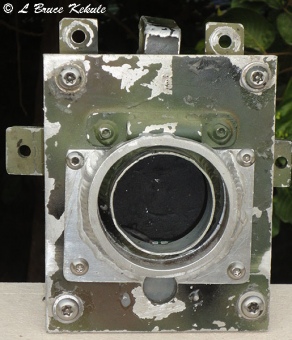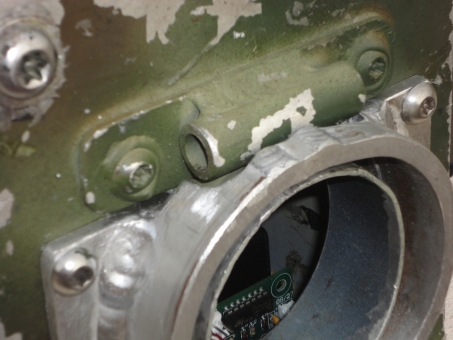Posts Tagged ‘trail cam’
Nikon D700 catches a male leopard on one paw…!
A big cat crossing the ‘tiger log’
Male leopard shot #1.
Male leopard on one paw….shot #2.
Male elephant – the flash destroyer.
Elephant back for more.
Banteng bull.
Evert year, forest fires occur in Thailand’s ‘Western Forest Complex’ during the dry season usually started by the human population living around the protected areas. Occasionally, lightning ignites fires but this natural phenomena, is less frequent. Stray cigarette butts also account for many fires. For the most part, local poachers start them to allow long distance spotlighting during the night. With the brush gone, they are able to see the reflection in the eyes distinctly (usually deer) with their headlamps.
Occasionally these fires are fierce and any camera trap left in the forest during this time will likely be destroyed. I always move my cams to evergreen forests from about February through to April that normally do not have fire, and this year was no different. But as soon as the first monsoon rains come in mid-April, the forest is safe once again for camera trapping.
With the first good rains through, I decided to setup my Nikon D700 back on the log. This time the cam is using a hardwired SSII sensor (Snapshotsniper.com) with a 10-meter cable setup in the tree stump apposite the cam. Also, a third flash was added and installed above the cam’s ‘elephant proof ‘ box. However, the ‘third flash’ is now history as a young tusker found it and turned it into rubble (below) but the cam, the sensor and two other flashes survived.
It was great to see this male leopard cross over the log. The first image is a good record shot but the second one is really something special catching this mature predator on one paw with the other three in mid-air. Also, the reproductive organ is sharp and just hanging there with its tail is balancing the big cat. He looks like he is winking at the cam. Once again, within two shots, the leopard turned his head to see what the flash was all about just like my tiger in late January 2014. The speed and reaction time of these felines is legendary and it doesn’t get any better…!
I also got the elephant that destroyed the third flash plus a banteng bull that stopped short but did not cross over. All in all, it was a great start to a new season at the ‘tiger log’. The full-frame D700 firing off a two-shot burst is in its element with a 28mm lens but now with only two flashes thanks to the forest giant. I have installed a 35mm lens this time to see what a tighter crop will do. Enjoy..!
Damaged SB-28 flash.
Nikon D700 setup on the log.
Hardwired external SSII (Snapshotsniper.com) sensor.
Hardwired Nikon SB-28 flash setup.
*****************************************
D700 settings: ƒ8 – 1/125 at ISO 400.
Edited in Adobe Camera Raw.
Leopard shot #1: full-frame.
Leopard shot #2: cropped.
Elephant and banteng bull: full-frame.
Sony A500 trail cam catches a wild elephant in ‘musth’
You never know what might show-up at a DSLR but when in elephant country, it’s pretty certain the big herbivore will pass the cam. However, this middle-aged wild male elephant was in a state of ‘musth’, a serious natural affliction. It would be a disaster if you bumped into this guy in the forest. Better to catch him with a trail cam…much safer..!
‘Musth’ is known to affect both wild and domestic elephants. It is an extremely dangerous time to be around one when it occurs characterized by highly aggressive behavior and accompanied by a large rise in reproductive hormones. A smelly liquid seeps from the temporal gland and sometimes into the mouth. These males have headaches causing severe pain. Needless to say, it was a great catch, something that is not documented to often, specially in the wild…! Enjoy..!!
Canon 400D DSLR catches an elephant’s trunk
A new location waiting on tiger…!
Elephant’s trunk right next to the SSII sensor hidden at the base of a tree.
It has taken awhile to get this trail cam working but it’s finally tripping well at a well-known tiger trail with plenty of battery life left in the cam and flashes after some two weeks in the field. This elephant was the first creature to cross in front of the external sensor set close to the log, and the Canon with two hard-wired SB-28s seems to be right on. I think the 400D with a Nikon 50mm ƒ1.4 manual lens looks perfect for tiger (settings: ISO 400 – ƒ8 @ 1/125). I have since added a third flash to help reduce any more shadows but that will have to wait till my next field trip next week. I look forward to checking this cam and evaluate if the third flash is really needed, and to readjust composition up a tad. Enjoy.
Canon 400D in an ‘elephant proof’ aluminum box with three Nikon SB-28 hard-wired flashes.
LBK testing the sensor and focus..!
Nikon D700 captures ‘big foot’
A wild elephant passing the log…!
Last month was a quiet one for my Nikon D700 trail cam…all I got was a big elephant going over the log…these are the two shots….I think the second one is unique and a bit abstract…!
The D700 is at a new location where I previously got tapir, tiger, gaur and elephant plus sambar and barking deer. Enjoy….more to follow.
A Jumping Tiger: Nikon D300s DSLR catches a big cat
The speed and reaction time of an Indochinese tiger is measured in milliseconds….!
The video is a bit raunchy and music is strong but I wanted something else for a change…! This is the most amazing behavior of a tiger I have ever seen.
I set my Nikon D300s DSLR trail cam deep in the forest at a mineral spring where all of Thailand’s large wild mammals like elephant, gaur, banteng, tapir and sambar plus others come for ‘life-giving’ minerals and a drink, and where tigers coming looking for prey.
This cam (set to manual 1/125 – ƒ8 – ISO 400) with a 35mm lens with a Snapshot Sniper SSII sensor fires-off salvos of 8 frames a second every time it records motion. The Nikon D300s was perfect for this location
I was hoping to catch a tiger and thought I might get lucky…but after going through the files, I found 13 photos of a tiger jumping away from the cam. This action footage is my best so far of the tiger in Thailand. The cat is not exceptionally sharp but movement never is and it does not have to be…..!
Amazingly, this male tiger heard the first shutter and reacted in less than three frames and started moving away in what I would like to say, blinding speed…! He looks to be mature judging from his scrotum. This place is truly the last great tiger haven in Thailand and worthy of it’s ‘World Heritage Site’ status…!
All I can say, it’s going to be tough to top this sequence….!
Enjoy…!
Nikon D90 DSLR trail cam catches a ‘Large Indian Civet’
The ‘Big Cat Trailhead’ has proven to be a real wildlife haven with loads of cats plus other carnivores walking past on almost a daily/nightly basis. Because of so much interaction, I decided to set-up my Nikon D90/SB400/Yeti/Plano 1460 case facing the other way opposite my Canon 400D.
The Yeti board was very old and not working too well. I tried to adjust distance and sensitivity but it still would only trip the cam from about a meter away. However, the cam did get one shot of a ‘Large Indian Civet’ shown here. The markings on this medium sized carnivore are unique and these creatures are very common in this forest.
I have since brought the cam home and replaced the board with a Snapshotsniper SSII #5 board and it is now ‘rocking and rolling’. Look forward to checking both cams in a couple of weeks and I’m confident there will be some interesting creatures walking past…! Enjoy.
Nikon SB-600/SB-800-900/SB-28 DSLR slave flash
Nikon remote flashes
Nikon SB-600 (middle), SB-800 (left) and SB-28 (right) remote flashes.
After installing and testing my D700 trail cam with several remote SB-28 flashes in the forest, it was apparent I needed another flash closer to the cam on the right side of the fallen tree to eliminate the shadow.
I had an old SB-600 that has been one of my mainstay flashes for some time and since I don’t shoot much flash now, thought I would regulate this one to camera trap duty.
SB-600 and SB-28 with Yongnuo Wireless flash triggers and ‘D’ cell externals.
I will be setting this flash with four brand-new ‘Enelope’ rechargeable batteries to see how long they will last on standby.
A Yongnue 602n wireless flash trigger and two ‘D’ cell externals is used and the assembly is housed in one of my ‘elephant proof’ aluminum boxes. I have now tested the ‘D’ cells and getting more than a month on stand-by…!
‘D’ cells in place.
On this box, I beefed-up the ends and drilled and tapped for 10mm machine screws and set with epoxy to act as pivots, and a ‘L’ bracket on the bottom and a 1” x ¼” x 14” aluminum strap across the top of the log. I can aim the flash straight at the trail and lock it in place. A generic flash diffuser is shortened to about 1/4″ and then ‘Goop’ is applied after camouflage painting.
By using two or three 3” x 3/8” stainless lag bolts, the flash will be tight, and elephants or bears would have hard time breaking these flashes. However, a bear-tooth through the diffuser could be a problem. Of course the proof is in the pudding and we shall see because the big elephant herd will come through one day, and they will surely have a go at destroying the whole set…!
SB-800 with an extra AA battery pack (5 AA cells).
In this box, I can also use a Nikon SB-28 flash that has a great stand-by feature, and is fairly cheap and readily available on the second hand camera market. A SB-800/900 can also be used.
I’m also working on a couple of SB-800s that will have extra Nikon battery packs (5-AAs) set to remote plus the 6-pack. During testing, they work extremely well but are still not TTL. Still working on that. Hope this helps those who need some tough slave flashes for your DSLR trail cam.
SB-800 with Nikon 6-AA battery pack.
Nikon D700 and Canon 350D trail cams on location
Nikon and Canon DSLR trail cams
Nikon D700 camera trap installed on a fallen tree trunk.
Set-up my Nikon D700 and Canon 350D at two locations in Huai Kha Khaeng that are frequented by tigers and leopards, plus many other Asian animals like elephant, gaur, banteng and more. Both cams trigger in continuous mode (three to four shots per actuation).
Nikon D700 camera trap with moss and old leaf camouflage.
The D700 was attached to a fallen tree with six legs bolted down with 3” x 3/8” stainless lag bolts. The transmitter was installed on an aluminum pole pounded into the ground and hidden in the tree roots.
Nikon ML-3 active infrared transmitter in aluminum box.
The Canon 350D was bolted to a standing tree with four lag bolts. Python cables secure both cams and the transmitter to the tree. They are both solid and if an elephant can move the tree, they can move the cams.
Canon 350D and flash installed on a tree next to a wildlife trail.
The Nikon has three flashes set off by ‘YongNuo’ wireless flash triggers with ‘D’ cell externals and three Nikon SB28s. The flashes trigger on the second shot.
Canon 350D beefed-up snorkel.
The Canon has only two flashes (Canon 270EXs) at the moment and this cam triggers them with the ‘YongNuo’ on the second shot too. A third Canon flash is in for repair after some ‘D’ cells leaked and left some residue in the box. I have beefed-up the snorkel as shown here and this should keep the elephants at bay.
Canon 350D beefed-up snorkel – close up.
I’m using four AA ‘Energizer’ Lithium batteries as power in the flashes and we’ll see how long they can last. The next job would be to add externals or ‘flash battery packs’ if the Lithium batteries are not enough for a month’s soak. I’ll be checking the Nikon and the Canon on May 17th and post something after that.





